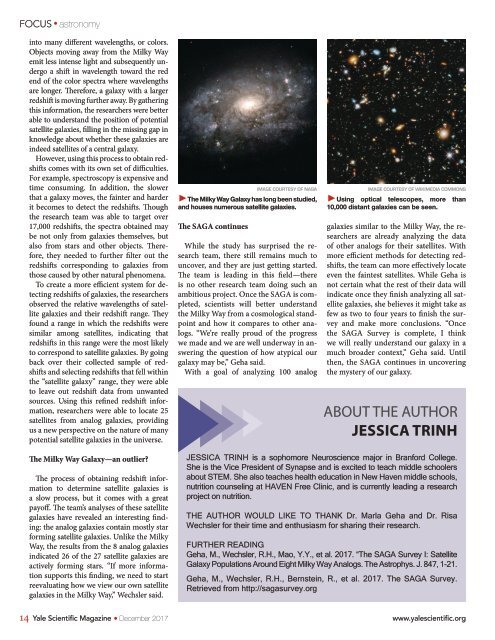YSM Issue 90.5
Create successful ePaper yourself
Turn your PDF publications into a flip-book with our unique Google optimized e-Paper software.
FOCUS<br />
astronomy<br />
into many different wavelengths, or colors.<br />
Objects moving away from the Milky Way<br />
emit less intense light and subsequently undergo<br />
a shift in wavelength toward the red<br />
end of the color spectra where wavelengths<br />
are longer. Therefore, a galaxy with a larger<br />
redshift is moving further away. By gathering<br />
this information, the researchers were better<br />
able to understand the position of potential<br />
satellite galaxies, filling in the missing gap in<br />
knowledge about whether these galaxies are<br />
indeed satellites of a central galaxy.<br />
However, using this process to obtain redshifts<br />
comes with its own set of difficulties.<br />
For example, spectroscopy is expensive and<br />
time consuming. In addition, the slower<br />
that a galaxy moves, the fainter and harder<br />
it becomes to detect the redshifts. Though<br />
the research team was able to target over<br />
17,000 redshifts, the spectra obtained may<br />
be not only from galaxies themselves, but<br />
also from stars and other objects. Therefore,<br />
they needed to further filter out the<br />
redshifts corresponding to galaxies from<br />
those caused by other natural phenomena.<br />
To create a more efficient system for detecting<br />
redshifts of galaxies, the researchers<br />
observed the relative wavelengths of satellite<br />
galaxies and their redshift range. They<br />
found a range in which the redshifts were<br />
similar among satellites, indicating that<br />
redshifts in this range were the most likely<br />
to correspond to satellite galaxies. By going<br />
back over their collected sample of redshifts<br />
and selecting redshifts that fell within<br />
the “satellite galaxy” range, they were able<br />
to leave out redshift data from unwanted<br />
sources. Using this refined redshift information,<br />
researchers were able to locate 25<br />
satellites from analog galaxies, providing<br />
us a new perspective on the nature of many<br />
potential satellite galaxies in the universe.<br />
The SAGA continues<br />
IMAGE COURTESY OF NASA<br />
►The Milky Way Galaxy has long been studied,<br />
and houses numerous satellite galaxies.<br />
While the study has surprised the research<br />
team, there still remains much to<br />
uncover, and they are just getting started.<br />
The team is leading in this field—there<br />
is no other research team doing such an<br />
ambitious project. Once the SAGA is completed,<br />
scientists will better understand<br />
the Milky Way from a cosmological standpoint<br />
and how it compares to other analogs.<br />
“We’re really proud of the progress<br />
we made and we are well underway in answering<br />
the question of how atypical our<br />
galaxy may be,” Geha said.<br />
With a goal of analyzing 100 analog<br />
IMAGE COURTESY OF WIKIMEDIA COMMONS<br />
►Using optical telescopes, more than<br />
10,000 distant galaxies can be seen.<br />
galaxies similar to the Milky Way, the researchers<br />
are already analyzing the data<br />
of other analogs for their satellites. With<br />
more efficient methods for detecting redshifts,<br />
the team can more effectively locate<br />
even the faintest satellites. While Geha is<br />
not certain what the rest of their data will<br />
indicate once they finish analyzing all satellite<br />
galaxies, she believes it might take as<br />
few as two to four years to finish the survey<br />
and make more conclusions. “Once<br />
the SAGA Survey is complete, I think<br />
we will really understand our galaxy in a<br />
much broader context,” Geha said. Until<br />
then, the SAGA continues in uncovering<br />
the mystery of our galaxy.<br />
ABOUT THE AUTHOR<br />
JESSICA TRINH<br />
The Milky Way Galaxy—an outlier?<br />
The process of obtaining redshift information<br />
to determine satellite galaxies is<br />
a slow process, but it comes with a great<br />
payoff. The team’s analyses of these satellite<br />
galaxies have revealed an interesting finding:<br />
the analog galaxies contain mostly star<br />
forming satellite galaxies. Unlike the Milky<br />
Way, the results from the 8 analog galaxies<br />
indicated 26 of the 27 satellite galaxies are<br />
actively forming stars. “If more information<br />
supports this finding, we need to start<br />
reevaluating how we view our own satellite<br />
galaxies in the Milky Way,” Wechsler said.<br />
JESSICA TRINH is a sophomore Neuroscience major in Branford College.<br />
She is the Vice President of Synapse and is excited to teach middle schoolers<br />
about STEM. She also teaches health education in New Haven middle schools,<br />
nutrition counseling at HAVEN Free Clinic, and is currently leading a research<br />
project on nutrition.<br />
THE AUTHOR WOULD LIKE TO THANK Dr. Marla Geha and Dr. Risa<br />
Wechsler for their time and enthusiasm for sharing their research.<br />
FURTHER READING<br />
Geha, M., Wechsler, R.H., Mao, Y.Y., et al. 2017. “The SAGA Survey I: Satellite<br />
Galaxy Populations Around Eight Milky Way Analogs. The Astrophys. J. 847, 1-21.<br />
Geha, M., Wechsler, R.H., Bernstein, R., et al. 2017. The SAGA Survey.<br />
Retrieved from http://sagasurvey.org<br />
14 Yale Scientific Magazine December 2017 www.yalescientific.org


















